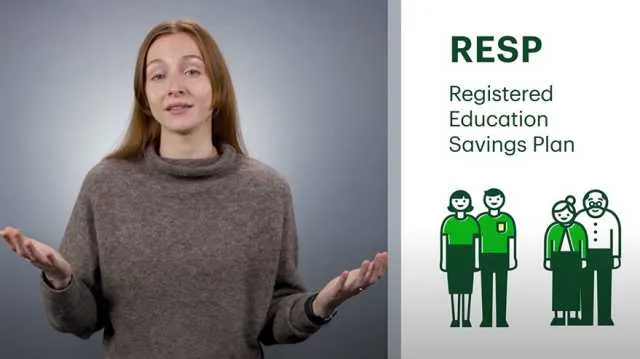Automatic RESP Enrollment Begins in 2028: How Parents and Kids Will Benefit

Starting in 2028, automatic RESP enrollment begins in 2028, revolutionizing how Canadian families save for post-secondary education.
This groundbreaking policy shift, announced by the Government of Canada, ensures that eligible children born in or after 2024 will have a Registered Education Savings Plan (RESP) opened on their behalf by age four, provided they have a valid Social Insurance Number (SIN) and are not already named in an existing RESP.
This initiative, paired with the Canada Learning Bond (CLB), promises to ease financial burdens and expand access to education.
But how exactly will this change the game for parents and kids?
Let’s dive into the benefits, mechanics, and transformative potential of this policy, exploring why it’s a beacon of hope for Canada’s future.
This initiative is expected to significantly increase the number of families saving for education, ensuring that financial barriers do not hinder children’s access to higher learning opportunities.
A Game-Changer for Financial Planning
Imagine planting a seed today that grows into a sturdy tree by the time your child is ready for university.
That’s the essence of automatic RESP enrollment begins in 2028.
For many parents, saving for their child’s education feels like navigating a labyrinth—complex, time-consuming, and sometimes intimidating.
The new policy simplifies this by automatically setting up an RESP for eligible children, ensuring no family misses out due to lack of awareness or bureaucratic hurdles.
The CLB, which provides up to $2,000 per child for low-income families, will be deposited directly into these accounts, offering a financial springboard without requiring parental contributions.
This change is particularly beneficial for families who may not have the time or resources to navigate the traditional RESP setup process.
This initiative tackles a critical issue: accessibility.
As of 2023, only 43.1% of eligible children received the CLB, leaving 2.7 million kids without this benefit due to unopened RESPs.
By automating enrollment, the government projects an additional 130,000 children will access the CLB annually starting in 2028.
This isn’t just about money—it’s about leveling the playing field, ensuring that children from all economic backgrounds have a shot at higher education.
Why This Matters for Parents
For parents, the automatic RESP enrollment begins in 2028 removes a significant mental load.
Opening an RESP traditionally involves researching financial institutions, understanding government grants, and navigating eligibility criteria.
Now, the government takes the first step, notifying caregivers via letters about their child’s eligibility and offering options to manage or opt out of the RESP.
This proactive approach empowers parents, particularly those juggling tight schedules or limited financial literacy, to focus on what matters: their child’s future.
This is especially important for single parents or those working multiple jobs, as it reduces the burden of financial planning.
Consider Sarah, a single mother in Vancouver working two jobs.
She’s aware of RESPs but hasn’t had the time to visit a bank or decipher the paperwork.
With automatic enrollment, her son, Liam, born in 2024, will have an RESP opened by 2028, with $500 from the CLB deposited automatically.
Sarah can choose to contribute later or let the account grow with government funds, giving Liam a head start on his education savings without her needing to act immediately.
+ How to Get a Student Visa for Canada: Everything You Need to Know
Empowering Kids for a Brighter Future
The benefits for children are profound.
Automatic RESP enrollment begins in 2028 ensures that every eligible child has a financial foundation for post-secondary education, whether it’s university, college, trade school, or an apprenticeship.
The CLB, which provides $500 initially and $100 annually until age 15 (up to $2,000), grows tax-free in the RESP.
This means a child like Liam could have thousands of dollars by the time they’re ready for post-secondary studies, even if their family contributes nothing.

This financial security allows children to pursue their educational goals without the overwhelming burden of student debt.
Beyond the dollars, this policy sends a powerful message: education is a priority, and every child deserves access.
For kids in low-income households, the CLB can cover textbooks, transportation, or even part of tuition, reducing reliance on student loans.
It’s a stepping stone to economic mobility, helping break cycles of poverty.
For example, consider Aisha, a teenager in rural Manitoba.
Her family’s modest income qualifies her for the CLB, and with automatic enrollment, she’ll have funds waiting when she decides to pursue a carpentry apprenticeship.
This financial support could mean the difference between starting her career debt-free or grappling with loans.
The Ripple Effect on Society
Why should we care about automatic RESP enrollment begins in 2028?
Because education is the backbone of a thriving economy.
By ensuring more children have access to post-secondary opportunities, Canada strengthens its workforce, fosters innovation, and reduces economic inequality.
The policy aligns with global trends emphasizing education as a driver of competitiveness.
Countries like Finland and Singapore have long invested in universal education access, and Canada’s move signals a commitment to similar values.
This commitment to education can also enhance Canada’s global competitiveness, attracting talent and investment.
The initiative also addresses a cultural stigma, as noted by MP Peter Fragiskatos, who highlighted the growing recognition of trades and vocational programs.
By supporting diverse educational paths—apprenticeships, colleges, and universities—automatic enrollment ensures kids aren’t pressured into a one-size-fits-all academic track.
It’s like giving every child a toolbox: some will build skyscrapers, others will craft furniture, but all have the tools to succeed.
How It Works: Mechanics and Flexibility
Delving into the nuts and bolts, automatic RESP enrollment begins in 2028 targets children born in or after 2024 who meet CLB eligibility criteria, primarily based on family income.
The adjusted family income—calculated as the primary caregiver’s pre-tax income minus certain benefits—determines eligibility.
For instance, families with a net income below $48,535 in 2020 qualified for additional grants.
The government will open an RESP with a trusted promoter, deposit the CLB, and notify caregivers, who can then:
- Take over the RESP and make contributions to attract the Canada Education Savings Grant (CESG), which matches 20% of contributions up to $7,200 per child.
- Opt out if they prefer a different savings plan.
- Transfer funds to another RESP if they already have one.
++ How the Canadian Education System Works: From Kindergarten to University
This flexibility allows families to tailor their savings strategy to their individual needs and circumstances.
This flexibility ensures parents retain control while benefiting from a hassle-free start.
The table below outlines the key components of the CLB and CESG under the new policy:
| Benefit | Description | Maximum Amount | Eligibility Criteria |
|---|---|---|---|
| Canada Learning Bond (CLB) | Government deposit for low-income families, no contributions required | $2,000 lifetime | Adjusted family income, child born 2004+ |
| Canada Education Savings Grant (CESG) | 20% match on contributions, up to $500/year | $7,200 lifetime | Contributions up to $2,500/year, child under 18 |

Addressing Barriers and Misconceptions
One of the biggest hurdles to RESP uptake has been awareness.
Many families, especially in underserved communities, don’t know about the CLB or how to access it.
Automatic RESP enrollment begins in 2028 dismantles this barrier by proactively creating accounts and informing caregivers.
It’s a bold step toward inclusivity, ensuring no child is left behind due to systemic gaps.
Raising awareness about these benefits is crucial to maximizing the impact of the program.
Another misconception is that RESPs are only for university-bound kids.
In reality, funds can cover a range of programs, from culinary schools to welding apprenticeships.
If a child opts out of post-secondary education, subscribers can withdraw contributions tax-free, though grants must be returned, and earnings face taxes plus a 20% penalty.
This flexibility mitigates risks for families, making the RESP a low-stakes investment.
Strategic Contributions for Maximum Impact
For parents who can contribute, the automatic RESP enrollment begins in 2028 pairs beautifully with the CESG.
By contributing $2,500 annually, families can secure an additional $500 per year in grants, up to $7,200 per child.
Lower-income families may qualify for an extra 10-20% on the first $500 contributed annually, amplifying returns.
The table below illustrates potential savings with consistent contributions:
| Yearly Contribution | CESG (20%) | CLB | Total Savings (18 Years, 6% Growth) |
|---|---|---|---|
| $0 | $0 | $2,000 | $3,400 (CLB only) |
| $2,500 | $500 | $2,000 | $74,000 (Contributions + CESG + CLB) |
*Assumes 6% annual compound growth, reinvested distributions.
This strategy not only maximizes government incentives but also fosters a culture of saving for education among families.
This strategy maximizes government incentives while leveraging tax-free growth.
For parents like Sarah, even small contributions—say, $50 monthly—can grow significantly over 18 years, especially with the CLB as a foundation.
For more information, visit Canada.ca.
Challenges and Considerations
No policy is without challenges.
Automatic RESP enrollment begins in 2028 relies on families having a valid SIN for their child, which may pose issues for newcomers or those in remote areas.
The government must ensure robust outreach to address this.
Additionally, while the CLB is a lifeline for low-income families, middle-income households may feel overlooked, as they don’t qualify but still face rising education costs, estimated at $90,000 for a four-year degree.
Addressing these challenges will be crucial for the successful implementation of the program.
There’s also the question of investment management.
Automatically opened RESPs will be held by government-selected promoters, but parents must verify these align with their financial goals.
Choosing a promoter with low fees and diverse investment options is crucial to maximizing returns.
A Vision for the Future
As Canada gears up for automatic RESP enrollment begins in 2028, the policy stands as a testament to forward-thinking governance.
It’s not just about saving money—it’s about investing in dreams, breaking down barriers, and building a nation where every child can reach their potential.
By automating the first step, the government empowers parents and kids alike, ensuring education isn’t a privilege but a right.
This vision aligns with Canada’s broader goals of social equity and economic growth.
For families, the message is clear: start early, leverage grants, and plan strategically.
Whether it’s Sarah saving for Liam’s engineering degree or Aisha pursuing her trade, automatic enrollment lays the groundwork for success.
So, what’s stopping us from embracing this opportunity to secure our children’s futures?
The path is clearer than ever—let’s walk it together.
